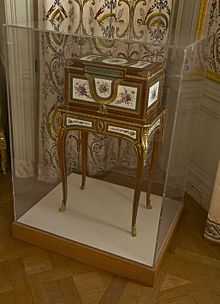Martin Carlin
Martin Carlin (ca 1730 – 1785) was a Parisian ébéniste, born at Freiburg, who was received master at Paris in 1766.
Carlin worked at first in the shop of Jean-François Oeben, whose sister he married.[1] He set up independently in the Faubourg Saint-Antoine, an unfashionable quarter of Paris, where few of his wealthy clientele would have penetrated. Carlin sold his works exclusively to marchands-merciers such as Simon-Philippe Poirier[2] and his partner Dominique Daguerre, who acted as decorator-designers. It was only through these entrepreneurs that Carlin could acquire the Sèvres porcelain plaques that decorate many of his pieces. His earliest such pieces are datable by the marks on their porcelain to 1766; they followed designs supplied by the dealer Poirier. Although Martin Carlin made some larger pieces— secrétaires à abattant (drop-front secretary desks), tables, and commodes— he is best known for refined small furnishings in neoclassical taste, some of them veneered with cut up panels of Chinese lacquer, which he would also have received from the hands of the marchands-merciers.
Collection
Bonheur du jour (Table à gradin dite )
- Bonheur du jour, 1765, Bowes Museum, UK
- Bonheur du jour, 1766, Musée Nissim de Camondo, France
- Bonheur du jour, 1766, Waddesdon Manor, UK
- Bonheur du jour, 1768, Boughton House, UK
- Bonheur du jour, 1768, delivered to the Comtesse du Barry, The Metropolitan Museum of Art, USA
- Bonheur du jour, 1769, The Metropolitan Museum of Art, USA
- Bonheur du jour, 1770, The Metropolitan Museum of Art, USA
- Bonheur du jour, 1770, The Huntington Library, USA
- Bonheur du jour, 1770, Waddesdon Manor, UK
- Bonheur du jour, 1771, The Huntington Library, USA
- Bonheur du jour, 1774, The Metropolitan Museum of Art, USA
Bureau plat (Writing table)
- Bureau plat, 1778, delivered to the Grand Duchess Maria Feodorovna and Grand Duke Paul Petrovich of Russia for the Palace of Pavlosk, Getty Museum, USA
Cabinet
- Cabinet, c. 1783, Royal Collection, UK

Coffret à bijoux
- Coffret à bijoux, 1770, delivered to Marie-Antoinette for the Petit Triannon, Château de Versailles, France
- Coffret à bijoux, c. 1770, delivered to the Comtesse du Barry, The Metropolitan Museum of Art, USA
- Coffret à bijoux, c. 1774, delivered to the Grand Duchess Maria Feodorovna and Grand Duke Paul Petrovich of Russia for the Palace of Pavlosk, Detroit Museum of Art, USA
- Coffret à bijoux, c. 1775, The Metropolitan Museum of Art, USA
- Coffret à bijoux, c. 1775, The Metropolitan Museum of Art, USA
Commode à vantaux (Commode with doors)
- Commode à vantaux, c. 1778, inset with Pietra Dure panels (one of Carlin's greatest examples), Royal Collection, UK
Encoignure (Corner cabinet)
- Pair of Encoignures, 1772, Wallace Collection, UK
Music-stand
- Music-stand, 1770-75, Getty Museum, USA
Music-stand and writing-table
- Music-stand and writing-table, 1786, given by Marie-Antoinette to Mrs William Eden (later Lady Auckland), V&A, UK
Reading stand
- Reading stand, c. 1780, V&A, UK
Secrétaire
- Secrétaire, 1775, Getty Museum, USA
- Secrétaire, 1776, Wallace Collection, UK
- Secrétaire, 1776-77, Getty Museum, USA
Secrétaire à abattant
- Secrétaire à abattant, 1770-80, V&A, UK
Table à ouvrage
- Table à ouvrage, 1770. delivered to the duchesse de Mazarin in 1779 for her dressing room, Getty Museum, USA
- Table à ouvrage, 1773, Getty Museum, USA
- Table à ouvrage, 1775, V&A, UK
- Table à ouvrage, 1783-84, Wallace Collection, UK
- Table à ouvrage, 1786, given by Marie-Antoinette to Mrs William Eden (later Lady Auckland), V&A, UK
Notes
- ↑ When Oeben died in 1763, Carlin, who was living nearby, was one of his creditors (Eriksen 1974:159).
- ↑ Other ébénistes working for Poirier were Roger Vandercruse Lacroix and Bernard II van Risamburgh
References
- Svend Eriksen, Early Neo-Classicism in France pp 159 (bio.)
Further reading
- Parker, James & Le Corbeiller, Clare (1979). A Guide to the Wrightsman Galleries at the Metropolitan Museum of Art. New York: The Metropolitan Museum of Art. ISBN 0-87099-186-8. (see index: p. 127-128; illustrations: p. 28, 50, 60-61)
External links
- (Getty Museum): Martin Carlin
- (Metropolitan Museum of Art) Bonheur-du-jour with Sèvres plaques, 1768
- (Royal Collection) Commode, ca 1778, with panels of pietra dura.